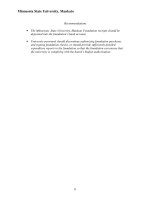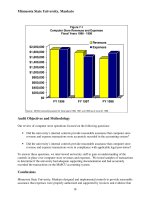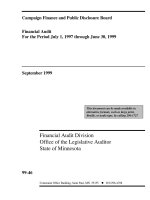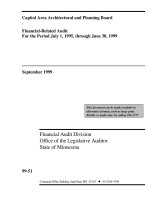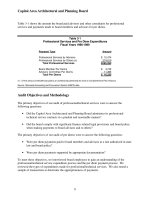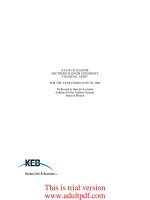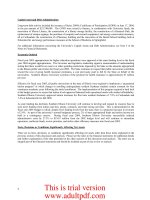Minnesota State University, Mankato Financial Audit For the Period July 1, 1995 through June 30, 1998_part3 doc
Bạn đang xem bản rút gọn của tài liệu. Xem và tải ngay bản đầy đủ của tài liệu tại đây (317.04 KB, 10 trang )
Minnesota State University, Mankato
18
Audit Objectives and Methodology
Our review of computer store operations focused on the following questions:
• Did the university’s internal controls provide reasonable assurance that computer store
revenue and expense transactions were accurately recorded in the accounting system?
• Did the university’s internal controls provide reasonable assurance that computer store
revenue and expense transactions were in compliance with applicable legal provisions?
To answer these questions, we interviewed university staff to gain an understanding of the
controls in place over computer store revenues and expenses. We tested samples of transactions
to determine if the university had adequate supporting documentation and had accurately
recorded the transactions on the MnSCU accounting system.
Conclusions
Minnesota State University, Mankato designed and implemented controls to provide reasonable
assurance that expenses were properly authorized and supported by invoices and evidence that
Figure 7-1
Computer Store Revenues and Expenses
Fiscal Years 1996 - 1998
$0
$200,000
$400,000
$600,000
$800,000
$1,000,000
$1,200,000
$1,400,000
$1,600,000
$1,800,000
$2,000,000
FY 1996 FY 1997 FY 1998
Revenues
Expenses
Source: MnSCU accounting system for fiscal years 1996, 1997, and 1998 as of June 30, 1998.
Minnesota State University, Mankato
19
equipment was received. However, the university did not design and implement internal controls
to provide reasonable assurance that computer store disbursement transactions were accurately
recorded in the accounting system. As discussed in Chapter 2, Finding 1, the university did not
record the correct occurrence dates for some computer store expenditures. In addition, the
university did not design adequate controls over revenue transactions, as discussed in Finding 5.
Finally, the university did not establish adequate controls over computer store inventory, as
discussed in Finding 6.
5. Controls over computer store receipts need improvement.
No one reconciled receipts recorded on the computer store accounting system (POSIM) to
receipts processed by the cashiers to ensure that all monies received were rung through the cash
register, posted to MnSCU accounting, and deposited. At the end of the day, the computer store
manager generated a report from POSIM which lists all transactions that were processed. The
store manager took all checks and credit card slips to the cashiers at the end of the day. The
cashiers prepared the bank deposit and posted the transactions on the Unisys system. The Unisys
system generated a detailed cashiers report that listed all the transactions posted to the system.
No one reconciled the POSIM report to the Unisys report to ensure that all receipts were
deposited and correctly posted. The lack of a reconciliation increased the risk of loss or theft.
Someone independent of the computer store should reconcile the computer store system to the
cashiers report.
In addition, computer store employees did not restrictively endorse checks “for deposit only”
immediately upon receipt. At the end of the day, the store manager endorsed the checks and
took them to the cashiers in the business office for processing.
Recommendations
• Someone independent should reconcile computer store receipts to the
accounting system.
• Computer store employees should restrictively endorse checks immediately
upon receipt.
6. Minnesota State University, Mankato did not establish adequate controls over
computer store inventory.
No one independent of the computer store operations compared the computer store physical
inventory results with the inventory records on the accounting system. Students working in the
store complete a physical inventory by scanning items on the shelves. The store manager
generated an on-hand inventory report from the system and compared the results. No one in the
Academic Affairs Department or the business office reviewed the results of the inventory.
Without an independent review, there is a risk that theft or errors could occur and not be
detected.
We also noted that the computer store inventory recorded on the system was not complete. The
store manager found some items stored in boxes that were not recorded on the system. All items
Minnesota State University, Mankato
20
on hand should be recorded on the inventory system. Total inventory on hand at March 31,
1999, was $83,797.
Recommendations
• Someone independent of computer store operations should review physical
inventory results.
• The university should record all inventory on the inventory system.
Minnesota State University, Mankato
21
Chapter 8. Other Revenue
Chapter Conclusions
Minnesota State University, Mankato’s internal controls provided reasonable
assurance that private grant revenue was accurately reported in the accounting
records. For the items tested, the university complied with finance-related legal
provisions.
Other revenue transactions relating to the Project for Automated Library
Systems (PALS) and the bookstore complied with contracts and were properly
recorded in the MnSCU accounting system.
Minnesota State University, Mankato receives additional revenue from various sources such as
private grants and endowments from various organizations, the university’s project for
automated library systems, and commissions from bookstore operations.
Minnesota State University, Mankato receives revenue from private grants and endowments
from various organizations. The university received some of the larger grants from U. S. West,
the Bloomington School District, IBM, and Americorps. Faculty receive approval to apply for
grants from the Grants and Sponsored Programs Office. The business office receives copies of
the grant award. The cashiers in the business office recorded the revenue on the Unisys system,
which interfaced nightly with the MnSCU accounting system. The cashiers also prepared the
deposits. The grant accountant in the business office reviewed the detailed cashier reports and
MnSCU accounting reports to ensure revenue was processed and recorded correctly. The
program accountant billed monthly for reimbursement grants. The university received
approximately $3.3 million in private grant revenue during fiscal year 1998.
Minnesota State University, Mankato receives revenue from its MnSCU/PALS (Project for
Automated Library Systems) project. The project is a statewide library automation and
telecommunications network. It serves all MnSCU institutions, several private colleges, and
some state agencies. The university developed the software and became the provider for
automating library services. The university houses a Unisys mainframe computer and all
operational sites are connected to it through a statewide telecommunications network. The
project employs 20 staff working out of MnSCU offices in the Memorial Library at Mankato
State. The employees provide technical training and support. Minnesota State University,
Mankato serves as the fiscal agent for PALS. Services are provided on a contract basis to private
colleges and libraries and state agency libraries. MnSCU system office authorizes all contracts.
Each participant pays annual dues that are determined by a formula that distributes costs in
proportion to use. Participants are billed twice a year, on January 1 and July 1, based on the
prior year’s transactions. During fiscal year 1998, PALS revenue totaled approximately $2.5
million.
Minnesota State University, Mankato
22
The university also contracted for bookstore operations. The university provided space and other
miscellaneous services to the vendor. The vendor provided documentation to support the
revenue amount and the commission the university earned. Total revenue for bookstore
commissions during fiscal year 1998 was $333,971.
Audit Objectives and Methodology
The primary objectives in our review of other revenues were as follows:
• Did the university design internal controls to provide reasonable assurance that private grant
revenue was safeguarded and accurately reported in the accounting records?
• Did the university administer private grant revenue in compliance with applicable legal
provisions?
• Were other revenue transactions in compliance with contracts and properly recorded in the
MnSCU accounting system?
To answer these questions, we interviewed university staff to gain an understanding of controls
over private grant revenue. We also tested private grant revenue transactions. We reviewed
contracts and transactions to determine whether other revenue transactions were properly
recorded in the MnSCU accounting system and in compliance with applicable finance-related
legal provisions and management’s authorization.
Conclusions
Minnesota State University, Mankato designed internal controls to provide reasonable assurance
that private grant revenue was accurately reported in the accounting records. For the items
tested, the university complied with finance-related legal provisions. Other revenue transactions
we tested complied with contracts and were properly recorded in the MnSCU accounting system.
Minnesota State University, Mankato
23
Status of Prior Audit Issues
As of May 29, 1998
Most Recent Audits
Legislative Audit Report 99-19, issued in March 1999, covered MnSCU activities material to
the state’s general purpose financial statements for the year ended June 30, 1998. The audit also
included coverage of federal financial aid programs administered by the State of Minnesota in
fiscal year 1998. The follow up on issues related to Minnesota State University, Mankato will be
conducted by MnSCU’s Office of Internal Auditing.
Other Audit History
Legislative Audit Report 98-16, issued in March 1998, covered material MnSCU financial
activities and federal financial aid programs administered by the State of Minnesota in fiscal year
1997. This report included a finding that four students received federal financial aid
overpayments. Certain overpayments have been recovered and other recoveries are in progress.
Legislative Audit Report 97-46, issued in August 1997, covered security over MnSCU’s
information systems. This report did not include any findings related specifically to Minnesota
State University, Mankato.
State of Minnesota Audit Follow-Up Process
The Department of Finance, on behalf of the Governor, maintains a quarterly process for following up on
issues cited in financial audit reports issued by the Legislative Auditor. However, Finance has delegated this
responsibility for audits of the Minnesota State Colleges and Universities (MnSCU) to the MnSCU Office of
Internal Auditing. MnSCU's Office of Internal Auditing process consists of quarterly activity reports
documenting the status of audit findings. The follow-up process continues until the Office of Internal
Auditing is satisfied that the issues have been resolved. The process covers all colleges and universities
within the MnSCU system.
Minnesota State University, Mankato
24
This page intentionally left blank.
Minnesota State University, Mankato's Responses to the Audit Findings and Recommendations Contained in the
Minnesota Office of the Legislative Auditor's Audit Report For the Period July 1, 1995 Through June 30, 1998.
1. Minnesota State University, Mankato did not properly record some financial transactions.
• Recommendation: The university should ensure that the occurrence date on the accounting system for year-
end computer store expenditures is the date the goods were received or services were provided.
Response: The Computer Store has a large volume of invoices to be processed for payments throughout the
year. In an effort to save data entry time and reduce the risk of data entry errors, invoices were grouped
together and paid as a single transaction, using an occurrence date within the time frame of the invoices
being processed. This practice was only done with Computer Store invoices due to the high volume in
that area. This practice was not utilized at fiscal year-end when occurrence dates are an important
element of determining year-end payables. During FY2000, individual entries are being made for each
invoice.
• Recommendation: The university should record capital improvements as betterments to buildings.
Response: The referenced contract for the purchase of a chiller for the power plant was recorded in the
HEAPR funds (Higher Education Asset Preservation and Replacement). The object code definitions for
1240 and 5210 are as follows:
1240: Repairs and Alterations to Buildings
5210: Betterments to Buildings
With some MnSCU object codes having similar or limited descriptions, it provides opportunity for
misclassification. We recommend that more detailed explanations and clarification of object codes and
their appropriate use be developed by MnSCU.
2. Minnesota State University, Mankato did not adequately restrict certain employee computer system
access privileges.
• Recommendation: Minnesota State University, Mankato should improve security access controls by:
either restricting access to MnSCU accounting based upon job responsibilities to ensure an adequate
separation of duties that would prevent unauthorized transactions from occurring, or developing and
reviewing management reports to ensure the propriety of the expenditure transactions; and
removing SCUPPS computer access by MnSCU system office staff; and
periodically reviewing system user security reports and modifying any inappropriate system access
privileges.
Response: We believe the best approach to resolving this issue is to develop reports that can be reviewed to
ensure the propriety of the expenditure transactions. We will work with MnSCU to develop the
appropriate reports. Also, we will ask MnSCU to adjust SCUPPS computer access to "view only"
privileges. Each unit will review their user security reports to assure all privileges are appropriate.
27
3. Minnesota State University, Mankato needs to clarify the operating relationship with its foundation.
• Recommendation:: The Minnesota State University, Mankato Foundation receipts should be deposited into the
foundation's bank account.
Response: Although our procedures for depositing foundation receipts were more efficient and no problems
have ever been encountered we will proceed with implementing this recommendation.
• Recommendation: University personnel should discontinue authorizing foundation purchases and signing
foundation checks, or should provide sufficiently detailed expenditure reports to the foundation so that the
foundation can ensure that the university is complying with the board's budget authorization.
Response: There are benefits to the university and to the Foundation to have university personnel involved in
the authorizing of foundation purchases and signing foundation checks, thus we will be discussing with
the Foundation the types of reports suggested for ensuring the university is complying with the board's
budget authorization.
4. Minnesota State University, Mankato did not complete a fixed asset inventory in a timely manner.
• Recommendation: The university should complete its periodic inventory and adjust accounting records in a
timely manner.
Response: We believe our inventory procedures are excellent and the staff takes seriously the importance of
fixed asset inventory records. To do a complete inventory count for a large campus such as Mankato, it
takes a number of months to do the work and then a number of months to follow up. The inventory was
completed in August, 1998, which is FY99. After it was completed, a report was generated in November,
1998 noting 239 items with a value of $752,303 were missing. The follow up during the next six months
resulted in the value of missing items being reduced to $583,554 with an undepreciated value of $21,424
still missing. Those items were written off in July, 1999 against the FY99 accounting records. The few
extra months of follow up resulted in approximately $170,000 less having to be written off.
5. Controls over computer store receipts need improvement.
• Recommendation:: Someone independent should reconcile computer store receipts to the accounting system.
• Recommendation: Computer store employees should restrictively endorse checks immediately upon receipt.
Response: We concur with the recommendations and have made organizational changes to assist us in
accomplishing them.
6. Minnesota State University, Mankato did not establish adequate controls over computer store inventory.
• Recommendation: Someone independent of computer store operations should review physical inventory
results.
• Recommendation: The university should record all inventory on the inventory system.
Response: We concur with the recommendations and have made organizational changes to assist us in
accomplishing them.

